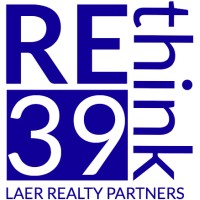The real estate industry has dodged a major cybersecurity crisis so far – but that might be more curse than blessing, according to industry security expert Robert Siciliano. Despite ha...
Adaptis: Leading Whole Life Cycle Building Optimization




“The most optimized building doesn’t have to be the most expensive, nor does the best performing building require the highest cost. Optimization means considering all different perspectives and making informed decisions based on available data,” says Sheida Shahi, CEO of Adaptis, a Toronto-based company revolutionizing how building owners approach capital projects and asset management.
The Architect Who Saw the Bigger Picture
As a registered architect in Canada with Iranian roots, Shahi’s professional journey began in 2007. Throughout her career working on retrofits and deep adaptive reuse projects—including school extensions, orchestra halls, and Ontario’s first net-zero energy multifamily building—she consistently encountered a fundamental challenge: the overwhelming complexity of decision-making in building projects.
“As architects, we are often the prime consultants on projects. We have significant responsibilities to align different consultants, objectives, and metrics, ensuring building owners receive the best possible product,” Shahi explains. “However, we frequently lack the necessary tools to accomplish this effectively.”
This realization led her back to school in 2017 to study construction management, a discipline she describes as “based on solving complexity.” The insights gained during this period became the foundation for Adaptis, which she founded with the mandate of bringing together multidisciplinary perspectives to help building owners make better-informed decisions about their most valuable assets.
Beyond Carbon: The Whole Life Cycle Approach
What sets Adaptis apart in the proptech landscape is its comprehensive approach to building optimization. While many solutions focus on specific aspects like operational carbon or embodied carbon, Adaptis takes a holistic view that considers the entire life cycle of a building.
“We’re solving the complicated problem in one go,” Shahi explains. “Buildings have such a long life cycle of decisions, and you’re making a decision now that might be implemented in the next 10 years. Making sure that decision is multi-faceted and optimized across multiple objectives is really what sets us apart.”
This approach extends beyond the traditional view of a building’s life span. “We don’t design buildings for one life cycle, which is defined as 60 years or 120 years depending on what standard you’re looking at,” Shahi notes. “We plan for multiple life cycles. That’s the way we can build the most efficient building—to plan for it to be around for a long time and to be in use and relevant for a very long time.”
The Unexpected Pivot to Portfolio-Wide Solutions
While Adaptis initially focused on optimizing individual buildings, they quickly discovered significant demand for portfolio-wide solutions. “We weren’t expecting the amount of interest on portfolios rather than buildings,” Shahi admits. “We’re seeing substantial interest from building owners who aren’t just thinking about one asset at a time, but have mandates across their portfolios and funds.”
This shift has allowed Adaptis to leverage its technology at scale, addressing challenges that would be impossible to solve through manual processes. “Initially, we conducted many single building assessments, work we can do better, faster, and cheaper. But consultants can also provide that,” Shahi explains. “When addressing multi-faceted problems at different orders of magnitude, we’ve been able to leverage our product team and technology to solve these larger challenges.”
Inside the Customer Journey
Adaptis works with diverse clients, from Global Affairs Canada assessing embassies to developers managing building transitions (school-to-residential, office-to-residential) and multifamily capital project optimization.
A typical customer journey begins with establishing baseline performance. “We help clients understand current building performance compared to targets,” Shahi explains. “We then optimize and sequence different capital projects based on targets, needs, and budgets to find the most cost-efficient path forward.”
The platform accommodates proprietary client data, such as cost information, creating a two-way conversation that enhances decision-making. “Incorporating client data into our simulations allows us to provide accurate assessments tailored to their specific circumstances,” Shahi says.
When a capital project is triggered, Adaptis distinguishes between investor-grade assessments and compliance-grade assessments. “For investment-grade decisions, we provide near real-time feedback,” Shahi explains. For compliance-grade projects, Adaptis provides precise assessments covering “from zero to 80%” of the process, with the final 20% involving compliance reports and professional engineering work.
Reframing Sustainability as Financial Value
While decarbonization and sustainability are central to Adaptis’s work, Shahi emphasizes that these goals ultimately align with financial objectives. “We work with pension funds or asset management groups that are connected to pension funds. They might have decarbonization targets, but ultimately, they care about building value and risk reduction,” she explains.
“Decarbonization targets exist to maximize a building’s residual value. We frame conversations around goals, pathways, opportunities for improvement, and risks of inaction.”
This approach allows building owners to make fully informed decisions: “I could spend 100 million dollars to reach certain performance targets and de-risk my building across specific metrics, or I can spend $50 million while understanding the associated risks and missed opportunities. That’s how financial decisions get made.”
Investors Recognize the Potential
Adaptis closed a $4 million seed round in June 2024, led by Building Ventures from Boston, with participation from MetaProp from New York and existing investors from their pre-seed round.
The company’s intellectual property centers on its adaptive engine, which combines operational and embodied carbon engines with proprietary methodologies for optimizing end-of-life building scenarios and assessing salvage value.
“When considering whole life cycle thinking—from upfront embodied carbon and operational carbon to end-of-life scenarios and circularity—significant value is often overlooked,” Shahi explains. “Incorporating these considerations into early-stage decisions represents another aspect of our differentiation.”
The Data Challenge: Building Models Where None Exist
Looking to the future, Adaptis is focused on expanding its geographical reach, with recent projects in Brazil and various regions in the United States. The company is also investing in enhancing its predictive models and machine learning methodologies.
A significant challenge in this area is data acquisition. “Unlike language models that access information across the internet, the data we need to train our models isn’t easily accessible or aggregated in centralized databases,” Shahi explains. “We must generate substantial synthetic data.”
This synthetic data helps bridge information gaps, particularly for Class B and Class C buildings where owners may lack comprehensive documentation. “Class A building owners can provide precise documentation, but Class B and C owners often cannot afford the documentation required for comprehensive assessments,” Shahi notes. “Our predictive models address this gap, though they require extensive data for effective learning.”
Changing How the Industry Thinks About Buildings
As regulatory requirements and investor expectations evolve, Adaptis is positioning itself to address emerging mandates and policies. “We work with asset management groups requesting whole life cycle Net Zero projects, which extend beyond standard net zero variables to consider complete life cycle impacts,” Shahi says.
By helping building owners understand the financial benefits of holistic optimization—for both immediate returns and long-term value preservation—Adaptis is changing how the industry approaches capital projects and asset management.
“The most sustainable building is the one that’s already built,” Shahi emphasizes. “It’s also the most cost-efficient. Our focus is ensuring buildings remain functional as long as possible, extending their useful life, maintaining them optimally, and establishing clear, optimized pathways for necessary capital projects from day one.”s, and metrics, ensuring building owners receive the best possible product,” Shahi explains. “However, we frequently lack the necessary tools to accomplish this effectively.”
This realization led her back to school in 2017 to study construction management, a discipline she describes as “based on solving complexity.” The insights gained during this period became the foundation for Adaptus, which she founded with the mandate of bringing together multidisciplinary perspectives to help building owners make better-informed decisions about their most valuable assets.
Beyond Carbon: The Whole Life Cycle Approach
What sets Adaptus apart in the proptech landscape is its comprehensive approach to building optimization. While many solutions focus on specific aspects like operational carbon or embodied carbon, Adaptus takes a holistic view that considers the entire life cycle of a building.
“We’re solving the complicated problem in one go,” Shahi explains. “Buildings have such a long life cycle of decisions, and you’re making a decision now that might be implemented in the next 10 years. Making sure that decision is multi-faceted and optimized across multiple objectives is really what sets us apart.”
This approach extends beyond the traditional view of a building’s life span. “We don’t design buildings for one life cycle, which is defined as 60 years or 120 years depending on what standard you’re looking at,” Shahi notes. “We plan for multiple life cycles. That’s the way we can build the most efficient building—to plan for it to be around for a long time and to be in use and relevant for a very long time.”
The Unexpected Pivot to Portfolio-Wide Solutions
While Adaptus initially focused on optimizing individual buildings, they quickly discovered significant demand for portfolio-wide solutions. “We weren’t expecting the amount of interest on portfolios rather than buildings,” Shahi admits. “We’re seeing substantial interest from building owners who aren’t just thinking about one asset at a time, but have mandates across their portfolios and funds.”
This shift has allowed Adaptus to leverage its technology at scale, addressing challenges that would be impossible to solve through manual processes. “Initially, we conducted many single building assessments, work we can do better, faster, and cheaper. But consultants can also provide that,” Shahi explains. “When addressing multi-faceted problems at different orders of magnitude, we’ve been able to leverage our product team and technology to solve these larger challenges.”
Inside the Customer Journey
Adaptus works with diverse clients, from Global Affairs Canada assessing embassies to developers managing building transitions (school-to-residential, office-to-residential) and multifamily capital project optimization.
A typical customer journey begins with establishing baseline performance. “We help clients understand current building performance compared to targets,” Shahi explains. “We then optimize and sequence different capital projects based on targets, needs, and budgets to find the most cost-efficient path forward.”
The platform accommodates proprietary client data, such as cost information, creating a two-way conversation that enhances decision-making. “Incorporating client data into our simulations allows us to provide accurate assessments tailored to their specific circumstances,” Shahi says.
When a capital project is triggered, Adaptus distinguishes between investor-grade assessments and compliance-grade assessments. “For investment-grade decisions, we provide near real-time feedback,” Shahi explains. For compliance-grade projects, Adaptus provides precise assessments covering “from zero to 80%” of the process, with the final 20% involving compliance reports and professional engineering work.
Reframing Sustainability as Financial Value
While decarbonization and sustainability are central to Adaptus’s work, Shahi emphasizes that these goals ultimately align with financial objectives. “We work with pension funds or asset management groups that are connected to pension funds. They might have decarbonization targets, but ultimately, they care about building value and risk reduction,” she explains.
“Decarbonization targets exist to maximize a building’s residual value. We frame conversations around goals, pathways, opportunities for improvement, and risks of inaction.”
This approach allows building owners to make fully informed decisions: “I could spend 100 million dollars to reach certain performance targets and de-risk my building across specific metrics, or I can spend $50 million while understanding the associated risks and missed opportunities. That’s how financial decisions get made.”
Investors Recognize the Potential
Adaptus closed a $4 million seed round in June 2024, led by Building Ventures from Boston, with participation from MetaProp from New York and existing investors from their pre-seed round.
The company’s intellectual property centers on its adaptive engine, which combines operational and embodied carbon engines with proprietary methodologies for optimizing end-of-life building scenarios and assessing salvage value.
“When considering whole life cycle thinking—from upfront embodied carbon and operational carbon to end-of-life scenarios and circularity—significant value is often overlooked,” Shahi explains. “Incorporating these considerations into early-stage decisions represents another aspect of our differentiation.”
The Data Challenge: Building Models Where None Exist
Looking to the future, Adaptus is focused on expanding its geographical reach, with recent projects in Brazil and various regions in the United States. The company is also investing in enhancing its predictive models and machine learning methodologies.
A significant challenge in this area is data acquisition. “Unlike language models that access information across the internet, the data we need to train our models isn’t easily accessible or aggregated in centralized databases,” Shahi explains. “We must generate substantial synthetic data.”
This synthetic data helps bridge information gaps, particularly for Class B and Class C buildings where owners may lack comprehensive documentation. “Class A building owners can provide precise documentation, but Class B and C owners often cannot afford the documentation required for comprehensive assessments,” Shahi notes. “Our predictive models address this gap, though they require extensive data for effective learning.”
Changing How the Industry Thinks About Buildings
As regulatory requirements and investor expectations evolve, Adaptus is positioning itself to address emerging mandates and policies. “We work with asset management groups requesting whole life cycle Net Zero projects, which extend beyond standard net zero variables to consider complete life cycle impacts,” Shahi says.
By helping building owners understand the financial benefits of holistic optimization—for both immediate returns and long-term value preservation—Adaptus is changing how the industry approaches capital projects and asset management.
“The most sustainable building is the one that’s already built,” Shahi emphasizes. “It’s also the most cost-efficient. Our focus is ensuring buildings remain functional as long as possible, extending their useful life, maintaining them optimally, and establishing clear, optimized pathways for necessary capital projects from day one.”
Similar Articles
Explore similar articles from Our Team of Experts.


“We’re supporting more sustainable infrastructure by using regenerative materials, such as soybeans and other agricultural oils that we can grow here in our backyard,” says...


“Technology adoption in real estate operations has been traditionally slow, so you have to make it so easy that anyone can do it,” explains Tiffany Mittal, Founder and CEO of Uti...


In a recent conversation with Craig Foley, a veteran real estate professional with over two decades of experience, we delved into the evolving landscape of sustainability in real estate. Fol...


In an era where digital transformation is reshaping property management, brokerage operations, and client acquisition strategies, the team at iCloudReady are pioneering comprehensive PropTec...




